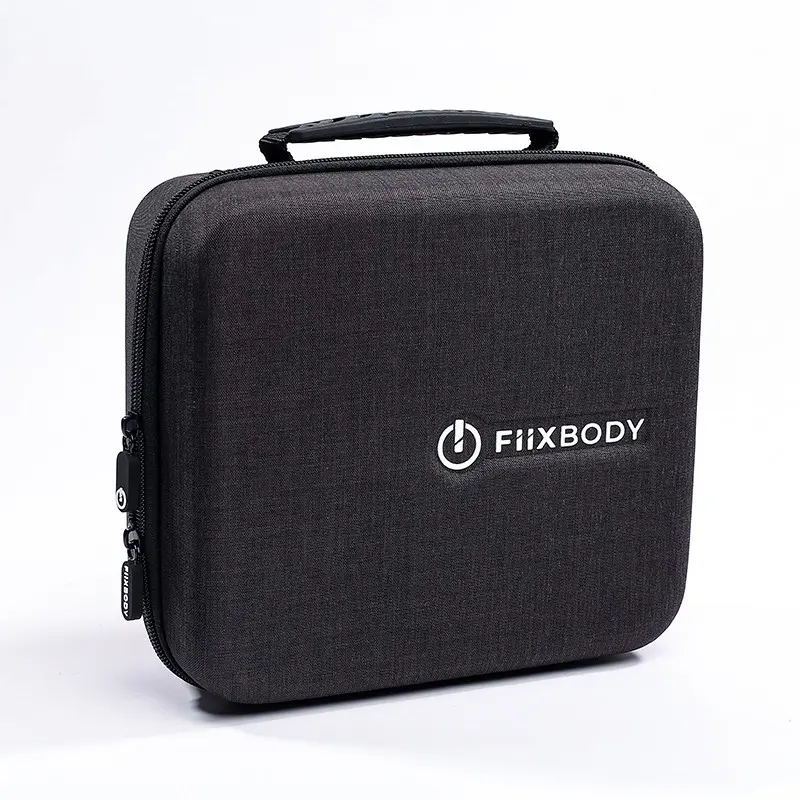Why are EVA tool bags the industry’s top choice?
Precision instruments—whether minimally invasive medical devices, chip testing equipment in electronics, or high-magnification lenses in optics—often possess the triple attributes of high precision, high value, and high fragility. They place extremely stringent demands on their storage environment: even the slightest vibration can cause calibration errors, traces of moisture can corrode circuitry, and even the slightest friction can scratch optical components. However, traditional storage solutions (such as ordinary cardboard boxes, sponge boxes, and plastic storage boxes) often suffer from inadequate protection and poor adaptability, leaving precision instruments vulnerable to shipping damage, storage damage, and difficult maintenance.
At this time, EVA tool bags, with their unique material properties and customization advantages, have gradually become the “standard” for precision instrument storage protection. Today, we’ll examine the core storage requirements of precision instruments and explain why EVA tool bags precisely address these industry pain points.
I, let’s understand: What exactly are precision instruments afraid of? Before discussing the advantages of EVA tool bags, we need to first clarify the three most serious threats to precision instrument storage:
Shock and vibration damage: Precision instruments often contain components such as precision gears, capacitors, and optical lenses. Even a 10cm drop or slight bumps during transportation can cause component dislocation and lens delamination, directly impacting accuracy (for example, a resolution deviation of only 0.1μm in an electron microscope can completely invalidate the test results).
Moisture and dust erosion: Most precision instruments are sensitive to humidity (for example, PCBs require a humidity of ≤40%). Moisture can cause oxidation of metal contacts and short circuits, while dust can clog instrument cooling vents or adhere to optical surfaces, affecting signal transmission.
The “hidden damage” of inadequate adaptability: Traditional general-purpose packaging cannot conform to the shape of the instrument, causing the instrument to shake and rub inside the bag. Long-term storage can cause scratches on the outer shell, wear on interfaces, and even loose internal components. These threats not only directly cause financial losses (a high-end precision instrument can be worth hundreds of thousands or even millions), but can also delay production, testing, or medical procedures due to instrument failure. The EVA toolkit is designed to specifically address these threats.
II. Core Advantage 1: Shockproofing, providing a “personal shock absorber” for instruments
The core characteristic of EVA (ethylene-vinyl acetate copolymer) material lies in its closed-cell structure. Unlike the open-cell design of sponges, each cell is independently sealed, forming a natural “shock-absorbing unit.” When an instrument is impacted, the EVA material disperses and absorbs the impact force through the compression and rebound of its cells, rather than transmitting it directly to the instrument.
Specifically, the cushioning advantages of EVA tool bags are reflected in three dimensions:
High resilience, fatigue resistance, and deformation resistance: High-quality EVA material has a rebound rate of over 90% (far exceeding the 60% of ordinary sponge). Even under prolonged pressure (such as when instruments are stored in the bag for a long time), it can quickly return to its original shape, preventing material collapse and protective failure.
Adjustable density to accommodate instruments of varying weights: EVA density can be customized between 0.3-0.8g/cm³. Lightweight precision instruments (such as portable spectrometers weighing approximately 500g) can use low-density EVA (0.3-0.4g/cm³) for both protection and portability. Heavy precision instruments (such as small testing equipment weighing 5kg or more) can use high-density EVA (0.6-0.8g/cm³) for greater support.
Compared to traditional solutions: Damage reduction rate exceeds 80%. An electronic equipment manufacturer conducted a comparative test in which 100 chip testing instruments were placed in either a standard sponge case or a standard sponge case. The results of the transportation of customized EVA tool kits showed that the instrument damage rate (including accuracy deviation and surface scratches) of the sponge box group was 18%, while that of the EVA tool kit group was only 2%, a damage rate reduction of more than 90%.
III. Core Advantage 2: Moisture- and Water-Resistant + Dust-Proof, Building a “Sealed Protective Shield”
One of the natural enemies of precision instruments is moisture and dust. EVA tool bags, through their material properties and process design, create a “three-dimensional protective barrier”:
Inherently moisture-resistant, blocking water vapor intrusion: EVA material itself has an extremely low water absorption rate (≤0.5%), and its closed-cell structure effectively blocks external moisture penetration. Some high-end EVA tool bags also feature a TPU waterproof film on the surface, achieving an IP65 waterproof rating (completely dust-proof and able to withstand water jets). This ensures that instruments within the bag remain dry, even in humid laboratory environments or during outdoor transportation.
Tightly fitting, eliminating gaps for dust: The EVA tool bag’s custom inner tray perfectly conforms to the contours of the instrument (the advantages of customization will be detailed later). There is virtually no gap between the bag body and the inner tray, preventing dust from entering at the source. Furthermore, the bag’s closure often features a zipper and… The Velcro double seal design further enhances dust protection.
Scenario Verification: The “Right Need for Moisture-Proofing” for Medical Instruments: A medical device company customized EVA tool kits for its minimally invasive laparoscopic instruments (required for sterile, moisture-proof storage). After storing the instruments in a 60% humidity environment for 30 days, testing revealed no signs of oxidation on the instruments’ metal interfaces and no loss of optical lens transmittance—fully meeting the medical industry’s stringent storage standards.
IV. Core Advantage 3: 1:1 Custom Adaptation, Giving Each Instrument a “Dedicated Workstation”
Precision instruments vary widely in shape—some have protruding connectors, some have slender probes, and some require separate compartments for accessories (such as calibration tools and data cables). Traditional, one-size-fits-all packaging simply cannot meet individual needs. The EVA tool kit’s customization capabilities are key to its success as a “precision instrument companion.” The EVA tool kit customization process is completely centered around instrument features:
Precise Measurement, ≤0.1mm Accuracy: 3D scanning or manual measurement captures instrument dimensions, protruding component locations, and weight distribution, ensuring a seamless fit between the inner support and the instrument.
Multi-Processing to Adapt to Complex Shapes: CNC engraving, hot stamping, and laser cutting are employed to accommodate diverse instrument configurations. For example, optical instruments with slender probes can be CNC-engraved with grooves and positioning points to prevent probe movement. For testing equipment requiring tiered storage, multi-layer EVA inner supports can be designed, with each layer dedicated to a different accessory.
Accessory Integration for Enhanced Usage: The EVA tool kit can be customized with elastic straps (for cable retention), small storage compartments (for screws and gaskets), transparent windows (for easy identification of instrument model), and even integrated shock-absorbing foam inserts. These ensure that instruments and accessories are perfectly positioned, preventing collisions and ensuring easy access. For example, an optical instrument manufacturer customized an EVA tool case for its high-magnification microscope lens, which is only 8mm in diameter. The inner support is not only carved with a curved groove that perfectly matches the lens, but also covered with a layer of soft EVA fleece on the inside to prevent scratches on the lens. The outside is designed with shock-absorbing bumps—even if the tool case is dropped from a height of 1.5 meters, the lens will remain intact.
V. Core Advantage 4: Durability + Compliance, Meeting Long-Term and Global Needs
For users of precision instruments, a storage solution must be not only user-friendly but also durable, meeting industry compliance standards. EVA tool bags excel in both of these aspects:
Aging and corrosion-resistant, with a service life exceeding 5 years: High-quality EVA material offers excellent weather resistance, resisting brittleness and deformation in temperatures ranging from -40°C to 80°C. Furthermore, EVA is insensitive to common cleaning agents like oils and alcohol, preventing material degradation even with prolonged exposure to instrument cleaning fluids.
Environmentally compliant, adaptable to global markets: Exporting precision instruments must comply with the environmental standards of the target market (such as EU REACH, US RoHS, and the FDA for the medical industry). EVA material does not contain heavy metals, phthalates, or other hazardous substances, and is certified by all of these certifications. This means that businesses operating independent export platforms no longer have to worry about material compliance becoming a barrier to ordering.
Lightweight, reducing shipping costs: Compared to traditional metal tool boxes, EVA tool bags weigh only 1/2 of the original. The EVA tool bag is 1/5 to 1/3 the weight of a 2kg test instrument (for example, an EVA tool bag itself weighs only about 300g), significantly reducing logistics costs during international transportation.
VI. Conclusion: EVA tool bags are more than just “storage containers,” they are “value protectors”
The value of precision instruments lies not only in their cost, but also in the production efficiency, testing accuracy, and medical safety they support. Choosing an EVA tool bag is essentially choosing an “active protection” solution—it mitigates the risk of instrument damage from the source through shock absorption, moisture and dust resistance, and custom fit. Its durability and compliance reduce long-term operating costs and export barriers.
Post time: Oct-15-2025




